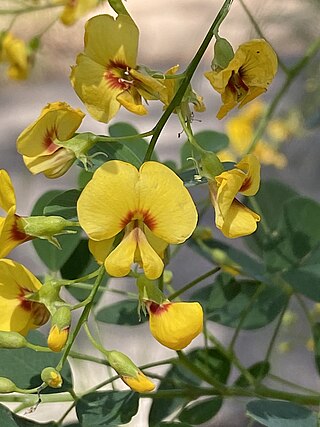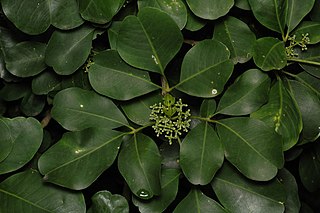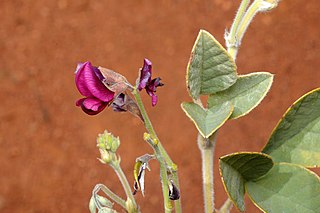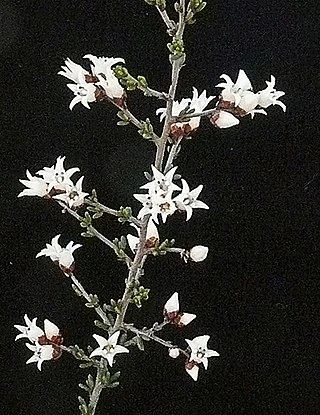
Thomasia tenuivestita is a species of flowering plant in the family Malvaceae and is endemic to the south-west of Western Australia. It is a shrub with its new growth covered with greyish, star-shaped hairs, and has egg-shaped leaves, and racemes of mauve flowers.

Lasiopetalum maxwellii is a species of flowering plant in the family Malvaceae and is endemic to the south coast Western Australia. It is a sprawling shrub with hairy young stems, lance-shaped to oblong leaves and white to cream-coloured flowers.

Melicope elleryana, commonly known as pink flowered doughwood, pink evodia, corkwood, or saruwa, is a species of rainforest shrub or tree in the family Rutaceae, and is native to New Guinea, parts of eastern Indonesia, the Solomon Islands and northern Australia. It has trifoliate leaves and pink to white, bisexual flowers arranged in panicles in leaf axils.

Goodia lotifolia, commonly known as golden tip or clover tree, is a species of flowering plant in the family Fabaceae and is endemic to eastern Australia. It is a sometimes tall shrub with trifoliate leaves, the leaflets narrowly egg-shaped with the narrower end towards the base, and bright yellow, pea-like flowers with red or brown markings.

Darwinia micropetala, commonly known as small darwinia, is a species of flowering plant in the family Myrtaceae and is endemic to south-eastern continental Australia. It is a small, erect shrub with linear leaves, and heads of white to pink flowers.
Melicope contermina is a species of shrub or small tree in the family Rutaceae and is endemic to Lord Howe Island. It has trifoliate leaves and white flowers borne in leaf axils in panicles of nine to fifteen flowers.

Melicope polybotrya is a species of shrub or small tree in the family Rutaceae and is endemic to Lord Howe Island. It has trifoliate leaves and green flowers borne in short panicles in leaf axils.

Kennedia lateritia, commonly known as Augusta kennedia, is a species of flowering plant in the family Fabaceae and is endemic to the south-west of Western Australia. It is a woody climber with twining stems, trifoliate leaves and orange-red and yellow flowers arranged in groups of up to twenty-four.

Cyanothamnus baeckeaceus is a plant in the citrus family, Rutaceae and is endemic to eastern Australia. It is a slender or straggling shrub with simple or trifoliate leaves and pink and white four-petalled flowers. It is endemic to the south-west of Western Australia.

Boronia filifolia, commonly known as the slender boronia, is a plant in the citrus family Rutaceae and is endemic to south-eastern Australia. It is a slender shrub with simple or pinnate leaves and pale to deep pink four-petalled flowers.

Boronia heterophylla, commonly known as red boronia or Kalgan boronia, is a plant in the citrus family Rutaceae, and is endemic to the south-west of Western Australia. It is an erect, slender shrub with trifoliate leaves and deep pink to red, four-petalled flowers arranged singly in leaf axils.

Acronychia acronychioides, commonly known as white aspen, is a species of small to medium-sized rainforest tree that is endemic to north-eastern Queensland. It has trifoliate leaves with elliptic to egg-shaped leaves on stems that are more or less cylindrical, creamy yellow flowers in large groups in leaf axils and fleshy, pear-shaped or spherical fruit.

Melicope vitiflora, commonly known as northern evodia, fishpoison wood, leatherjacket or leatherwood, is a species of shrub or small tree in the family Rutaceae and is native to north-eastern Australia and New Guinea. It has trifoliate leaves and green to white or cream-coloured flowers borne in panicles in leaf axils.
Goodenia stenophylla is a species of flowering plant in the family Goodeniaceae and is endemic to the south-west coast of Western Australia. It is an erect shrub with linear or tapering leaves and racemes of white flowers with purplish spots.

Kennedia beckxiana, commonly known as Cape Arid kennedia, is a species of flowering plant in the family Fabaceae and is endemic to the south-west of Western Australia. It is a prostrate or twining shrub or a climber with trifoliate leaves and red and yellow, pea-like flowers.

Kennedia prorepens is a species of flowering plant in the family Fabaceae and is endemic to Australia. It is a prostrate, multi-stemmed shrub with trifoliate leaves and pale blue, violet or maroon flowers.

Cryptandra magniflora is a species of flowering plant in the family Rhamnaceae and is endemic to Victoria (Australia). It is a shrub with cylindrical leaves, and clusters of white, tube-shaped flowers.

Commersonia magniflora is a species of flowering plant in the family Malvaceae and endemic to Australia. It is an erect shrub with wrinkled, narrowly oblong to elliptic or egg-shaped leaves, and deep pink flowers.

Androcalva melanopetala is a species of flowering plant in the family Malvaceae and is endemic to southern inland Western Australia. It is a sometimes prostrate shrub that has densely hairy new growth, egg-shaped to elliptic leaves with rounded teeth on the edges, and clusters of white or cream-coloured and pink to red flowers.

Leucopogon strongylophyllus is a species of flowering plant in the heath family Ericaceae and is endemic to the southwest of Western Australia. It is an erect shrub with crowded egg-shaped or round leaves and white, tube-shaped flower arranged singly or in pairs in leaf axils.


















